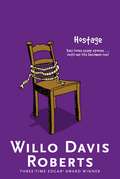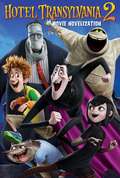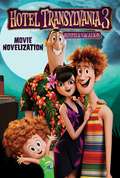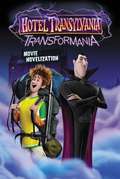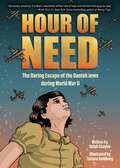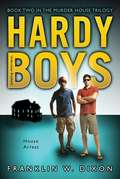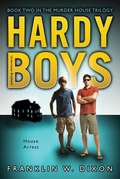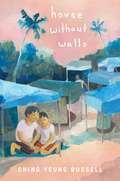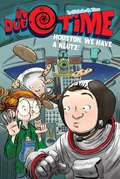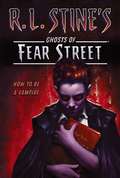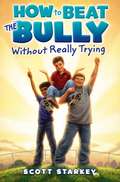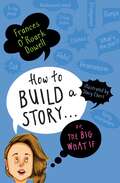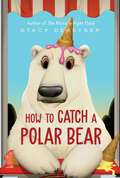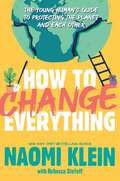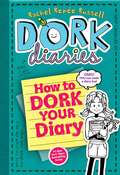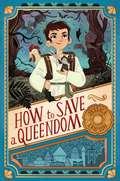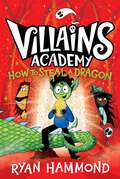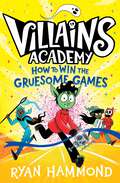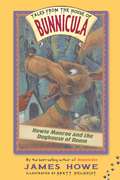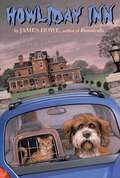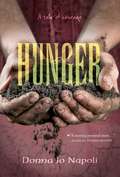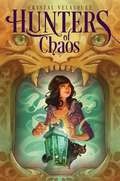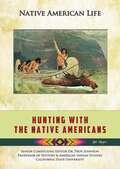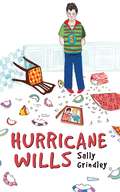- Table View
- List View
Hostage
by Willo Davis RobertsA young girl and her neighbor are kidnapped during a burglary gone awry in this hair-raising and fast-paced thriller from three-time Edgar Award-winning author Willo Davis Roberts.Sixth-grader Kaci Drummond longs for excitement and to be noticed just as her sister Jodie is for dancing, or her brother Jeff is for playing the piano. Shortly after her family moves to a new house, Kaci returns home in the middle of the school day and stumbles upon a burglary. The robbers kidnap her, and when a nosy neighbor suspects that something is wrong and tries to help, they take her as well. Kaci quickly discovers that the elderly woman not only has some good ideas, but also helps them both keep up their courage. Can the two hostages band together to escape their captors?
Hotel Transylvania 2 Movie Novelization: Movie Novelization (Hotel Transylvania 2)
by Stacia DeutschThis retelling of the hilarious monster comedy includes an eight-page insert of full-color images! Sony Pictures Animation's Hotel Transylvania 2 hits theaters September 25, 2015--just in time for Halloween!Everyone's favorite monsters are back for another exciting adventure in Hotel Transylvania! TM & © 2015 Sony Pictures Animation Inc. All Rights Reserved.
Hotel Transylvania 3 Movie Novelization (Hotel Transylvania 3: Summer Vacation)
by Stacia DeutschThis novelization of the hilarious monster comedy includes an eight-page insert of full-color images from the film! Sony Pictures Animation’s Hotel Transylvania 3—starring Adam Sandler and Selena Gomez—hits theaters July 13, 2018!Everyone’s favorite monsters are back for another exciting adventure in Hotel Transylvania! All aboard! Welcome to the Bermuda Triangle, where monsters embark on the cruise of a lifetime. Everyone’s favorite monsters are back, and this time, they’re funnier than ever. Join Dracula, Mavis, Johnny, Dennis, Frankenstein, Wayne the Werewolf, Murray the Mummy, Invisible Man Griffin, and more for a spook-tacular monster vacation that’s shore to be a good time. Find out what happens on this exciting cruise adventure in this hilarious monster comedy! ™ & © 2018 Sony Pictures Animation Inc. All Rights Reserved.
Hotel Transylvania Transformania Movie Novelization (Hotel Transylvania 4)
by Patty MichaelsTransylvania: Transformania Only in Theaters July 23, 2021 Get ready for another spook-tacular movie with your favorite monsters in the next installment of Sony Pictures Animation&’s Hotel Transylvania movie series, set to release on July 23, 2021. Relive every monster-rific minute of the film in this novelization that comes with an eight-page full-color glossy insert! ™ & © 2021 Sony Pictures Animation Inc. All Rights Reserved.
Hour of Need: The Daring Escape of the Danish Jews during World War II: A Graphic Novel
by Ralph ShayneHour of Need is a graphic novel telling the true story of the Nazi Resistance in Denmark during World War II and the heroes that saved the Danish Jews by helping them evacuate to Sweden.In the Hans Christian Anderson fairy tale, legend had it that should danger ever come to Denmark, the mighty warrior Holger Danske promised to wake from his centuries-long slumber to protect its citizens.When the Nazis move to round up young Mette and her fellow Danish Jews in a surprise raid in 1943 after years of letting Denmark rule its people, her father must make life and death decisions to save his family. Overnight, they have become refugees at the mercy of the complete strangers they meet during their escape. The mythical Holger Danske's promise to the Danish people manifests in the compassion and bravery of a school teacher turned resistance leader and other ordinary citizens who bravely defy the Nazi regime to come to her rescue in her hour of need.Told from the point of view of Mette returning to Denmark years later with her grandchildren, Hour of Need tells the story of how the people of an occupied nation--from king to fisherman--risked their lives to evacuate their Jewish countrymen to Sweden in small fishing boats. Hour of Need is a tribute to the heroes that saved the Danish Jews and how humanity triumphs in the darkest hours.Developed in partnership with the Illinois Holocaust Museum and Education Center. Find out more at ilholocaustmuseum.org.
House Arrest
by Franklin W. DixonATAC Briefing for Agents Frank and Joe Hardy MISSION: To stay undercover on the Deprivation House reality show and discover who's behind the continued "accidents" before someone else turns up dead. LOCATION: A huge villa in Beverly Hills, CA. POTENTIAL VICTIMS: All the remaining contestants and crew of the show. SUSPECTS: The list has been narrowed now that the culprit behind the initial crimes was caught, but someone living in that house still has murder on the mind.
House Arrest
by Franklin W. DixonATAC Briefing for Agents Frank and Joe Hardy MISSION: To stay undercover on the Deprivation House reality show and discover who's behind the continued "accidents" before someone else turns up dead. LOCATION: A huge villa in Beverly Hills, CA. POTENTIAL VICTIMS: All the remaining contestants and crew of the show. SUSPECTS: The list has been narrowed now that the culprit behind the initial crimes was caught, but someone living in that house still has murder on the mind.
House Without Walls
by RussellFor most people, home is a place with four walls. It's a place to eat, sleep, rest, and live. For a refugee, the concept of home is ever-changing, ever-moving, ever-wavering. And often, it doesn't have any walls at all.Eleven-year-old Lam escapes from Vietnam with Dee Dee during the Vietnamese Boat People Exodus in 1979, when people from Vietnam, Laos, and Cambodia fled their homelands for safety. For a refugee, the trip is a long and perilous one, filled with dangerous encounters with pirates and greedy sailors, a lack of food and water, and even the stench of a dead body onboard. When they finally arrive at a refugee camp, Lam befriends Dao, a girl her age who becomes like a sister-a welcome glimmer of happiness after a terrifying journey. Readers will feel as close to Lam as the jade pendant she wears around her neck, sticking by her side throughout her journey as she experiences fear, crushing loss, boredom, and some small moments of joy along the way. Written in verse, this is a heartfelt story that is sure to build empathy and compassion for refugees around the world escaping oppression.
Houston, We Have a Klutz!
by Nicholas O. TimeGrace sneaks onto Apollo 11 with a little help from some surprising allies in this fourth wacky novel, part of the all-new In Due Time series."Graceless Grace" is the smartest seventh grader at Sands Middle School, but she's constantly being teased for stumbling over doorjambs and knocking over lunch trays. And lately, the name-calling has been even worse. So when Ms. Tremt offers to lend The Book of Memories to Grace for an extended trip, she decides to go completely out of this world. She travels back to 1969 to stow away on Apollo 11 and become the first kid, the first female, and maybe even the first person to walk on the moon. Take that, teasers! Sneaking onboard Apollo 11 without messing up the mission requires some serious brainpower. Luckily, Grace has something NASA doesn't--a time portal. She opens up The Book of Memories and assembles her dream team: Isaac Newton, Albert Einstein, and Hypatia of Alexandria, and works with them to reduce the cargo just enough to safely board the rocket. Apollo 11 leaves the atmosphere with 6,099,920 pounds of space ship and eighty pounds of middle school girl. Grace impresses Neil Armstrong with her smarts and dazzles the world with her spacewalk. After all, you can't face-plant in zero gravity! But when Grace returns to the present, she's dismayed to discover NASA has covered up her historic achievement. There is no mention of her in history books, no record of her spacewalk. Some things in history can't be changed, explains Ms. Tremt, but people can change. And now, "Graceless Grace" has the confidence to redefine her reputation!
How to Be a Vampire
by R. L. StineLife was pretty average for Andrew. Until the morning he woke up undead. First there were bite marks on his neck. Then he tried to eat garlic--but that didn't work out so well. And now he's got this weird urge to sleep upside down.... Andrew's kind of excited about being a vampire. He'll get to fly, stay up all night, and totally scare his sister. But when he meets his vampire teacher, Andy realizes that being a vampire isn't as all it's cracked up to be....
How to Beat the Bully Without Really Trying
by Scott StarkeyWhen luck gives a new kid a false reputation as a tough guy, can he find the strength to live up to his image? Rodney Rathbone is a self-admitted coward. Things scare him, and he can't help it. So naturally he's terrified when he moves to a new town and the bully is ready to pounce. But just as Rodney is about to flee, a baseball flies in from out of nowhere and knocks out the bully. Now everyone thinks Rodney's invincible--when really he feels just the opposite. Can he figure out how to live up to his new reputation and make friends along the way? Told with warmth and heart, this debut novel from a middle-school teacher will speak to the hidden insecurities--and strengths--of every middle-grade reader.
How to Build a Story . . . Or, the Big What If
by Frances O'Roark DowellFrom bestselling author Frances O&’Roark Dowell comes a fresh and accessible guide to storytelling that breaks down the sometimes-daunting writing process into straightforward, doable steps, just right for budding writers!If you&’ve written anything, ever, you&’re already a writer—so, congratulations! As many aspiring authors know, though, telling an actual, complete story is, well, a different story. As unfinished drafts pile up and writers&’ block strikes, it may start to feel like there&’s a special formula to finishing a project that you&’re just not getting. But crafting a story isn&’t magic, if you have a little know-how! And here it is—know-how! In her witty, clever way, critically acclaimed author Frances O&’Roark Dowell explains the storytelling process with simple, easy-to-understand steps. Follow along as she shares sample stories and identifies building blocks and obstacles to conquer—all hilariously illustrated, in a way that&’ll have you typing all the way to the end of your own story. In addition to writing many books including Shooting the Moon and Dovey Coe, Frances O&’Roark Dowell has over a decade&’s experience teaching writing workshops for kids. Ready, set, write!
How to Catch a Polar Bear (Washington Park Stories)
by Stacy DeKeyserIn this &“funny and heartwarming&” (Booklist) historical fiction companion to The Rhino in Right Field, Nick&’s summer gets way more exciting when a polar bear escapes from the local zoo—perfect for fans of Stuart Gibbs and The One and Only Ivan.It&’s 1948, and twelve-year-old Nick is ready for the best summer ever. He&’s going to hang out with his best pal, Ace, and maybe with Penny too—she is a girl, but she has a great throwing arm. Then things get wild when a polar bear escapes from Milwaukee&’s city zoo and appears right on his block. They&’re all going to have to keep their eyes open now. But Nick&’s grand plans start to crumble when Ace gets a paper route and Penny decides to share it with him. Now they&’re never around. Nick himself is working at his Uncle Spiro&’s frozen custard shop, but at least he gets free all-you-can-eat dessert. When Uncle Spiro opens a custard stand at the zoo, Nick volunteers to help—if that polar bear escapes again, he&’ll have a front row seat! But their competitor, Happy Harold, opens a stand of his own right outside the zoo. Now Nick is scrambling to keep their customers, especially because Happy keeps playing dirty tricks. When Penny discovers that someone may have let the polar bear out on purpose, Nick suspects that Happy might be involved. With mysteries to solve and a whole zoo-full of monkey business, it looks like Nick&’s summer won&’t be so boring after all!
How to Change Everything: The Young Human's Guide to Protecting the Planet and Each Other
by Naomi KleinAn empowering, engaging young readers guide to understanding and battling climate change from the expert and bestselling author of This Changes Everything and On Fire, Naomi Klein.Warmer temperatures. Fires in the Amazon. Superstorms. These are just some of the effects of climate change that we are already experiencing. The good news is that we can all do something about it. A movement is already underway to combat not only the environmental effects of climate change but also to fight for climate justice and make a fair and livable future possible for everyone. And young people are not just part of that movement, they are leading the way. They are showing us that this moment of danger is also a moment of great opportunity—an opportunity to change everything. Full of empowering stories of young leaders all over the world, this information-packed book from award-winning journalist and one of the foremost voices for climate justice, Naomi Klein, offers young readers a comprehensive look at the state of the climate today and how we got here, while also providing the tools they need to join this fight to protect and reshape the planet they will inherit.
How to Dork Your Diary (Dork Diaries #3.5)
by Rachel Russell<P>Create your own Dork Diary! A special, interactive addition to the New York Times bestselling series. <P>Nikki Maxwell is living her worst nightmare--her diary is missing! As she retraces her steps to find the lost book, Nikki offers a list of important tips and advice on how to keep a diary. Follow Nikki's efforts to recover the missing diary--and deal with the usual funny, wacky antics of her best friends Chloe and Zoey, crush Brandon, and mean girl Mackenzie. It's crisis management...Dork Diaries style.
How to Read Food Product Labels (Understanding Nutrition: A Gateway to Ph)
by Kim EtingoffNutrition can be complicated. How do you know what foods are healthy and what aren't? How much should you eat? How can you use the food labels to find the answers to these questions? Food labels let you know what kinds of ingredients are in your food, and how many nutrients are in there. Discover how to read food labels--and how to use them to choose the best foods you can!
How to Save a Queendom
by Jessica LawsonFrom critically acclaimed author Jessica Lawson comes a whimsical fantasy about an orphaned twelve-year-old girl who is called upon to save her queendom when she finds a tiny wizard in her pocket.Life&’s never been kind to twelve-year-old Stub. Orphaned and left in the care of the cruel Matron Tratte, Stub&’s learned that the best way to keep the peace is to do as she&’s told. No matter that she&’s bullied and that her only friend is her pet chicken, Peck, Stub&’s accepted the fact that her life just isn&’t made for adventure. Then she finds a tiny wizard in her pocket. Orlen, the royal wizard to Maradon&’s queen, is magically bound to Stub. And it&’s up to her to ferry Orlen back to Maradon Cross, the country&’s capital, or else the delicate peace of the queendom will crumble under the power of an evil wizard queen. Suddenly Stub&’s unexciting life is chock-full of adventure. But how can one orphan girl possibly save the entire queendom?
How to Steal a Dragon (Villains Academy #2)
by Ryan HammondIn the second book of this illustrated middle grade series that&’s The Bad Guys meets Amelia Fang, Bram and his merry gang of almost-villains must protect a forest of dragons before someone else gets to them first.It&’s the start of the winter season and there&’s a new teacher in town at Villains Academy: the notorious dragon rider Felix Frostbite. Class Z is in awe of him and his lessons on venomous beasts and mythical creatures, but werewolf Bram is suspicious. Soon Bram and his friends the Weirdoughs uncover Felix Frostbite&’s evil plan to steal all the dragons from the Wicked Woods and leave Villains Academy undefended. Have the gang learnt enough to outsmart their troublesome teacher, or will Felix Frostbite&’s heist go down in villain history?
How to Win the Gruesome Games (Villains Academy #3)
by Ryan HammondIn the third book of this illustrated middle grade series that&’s The Bad Guys meets Amelia Fang, Bram and his merry gang of almost-villains participate in a school-wide sports tournament, the Gruesome Games.Once a year, the five original founders of Villains Academy rise from their graves in honor of the Gruesome Games—a school field day unlike any other, where the aim is to prank and cheat your way to the finish line. Werewolf Bram and his friends the Weirdoughs are determined to win so their names can be written in the Book of Bad, a record of the most wicked villains to grace the school. But when the pranks start getting out of hand and the Book of Bad is stolen, it&’s up to Bram and the gang to get to the bottom of the mystery.
Howie Monroe and the Doghouse of Doom: Tales From The House Of Bunnicula (Tales from the House of Bunnicula #3)
by James Howe Brett HelquistDear possible reader of this book,<P> My editor asked me to write a third book in my series, Tales from the House of Bunnicula. And did I have trouble getting started! I was afraid I used up all my ideas. But faster than a writer can say “What if?” I came up with a story! It’s about a lovable and smart (not to mention cute) orphan wirehaired dachshund puppy named Howie, who has a mysterious pain in his leg and is mysteriously invited to attend the Dogwiz Academy for Canine Conjurers. Together, Howie and his best friend, the very, very, very smart Delilah, who speaks in a British accent in this book for some reason, discover they must fight a sinister foe…The-Evil-Force-Whose-Nam-C’not-Be-Spoke!!!<P> Your friend, Howie
Howliday Inn (Bunnicula and Friends #2)
by James HoweHarold and Chester could hardly believe it. The Monroe family was going on vacation without them. Bunnicula, the family rabbit, would be boarded with a neighbor. But they, the family's loyal dog and cat, were to be sent away with strangers; they were to spend a week at Chateau Bow-Wow.Chateau Bow-Wow, observed Chester, soon after they arrived, could more properly be called Howliday Inn. Though what was howling, neither of them knew. Chester had his suspicions however; only a werewolf could make that chilling sound.
Hunger: A Tale of Courage
by Donna Jo NapoliThrough the eyes of twelve-year-old Lorraine this haunting novel from the award-winning author of Hidden and Hush gives insight and understanding into a little known part of history—the Irish potato famine. <P><P>It is the autumn of 1846 in Ireland. Lorraine and her brother are waiting for the time to pick the potato crop on their family farm leased from an English landowner. But this year is different—the spuds are mushy and ruined. What will Lorraine and her family do? Then Lorraine meets Miss Susannah, the daughter of the wealthy English landowner who owns Lorraine’s family’s farm, and the girls form an unlikely friendship that they must keep a secret from everyone. Two different cultures come together in a deserted Irish meadow. And Lorraine has one question: how can she help her family survive? <P><P> A little known part of history, the Irish potato famine altered history forever and caused a great immigration in the later part of the 1800s. Lorraine’s story is a heartbreaking and ultimately redemptive story of one girl’s strength and resolve to save herself and her family against all odds.
Hunters of Chaos
by Crystal VelasquezFour girls at a southwestern boarding school discover they have amazing feline powers and must unite to stop an ancient evil in this riveting adventure.Ana's average, suburban life is turned upside down when she's offered a place at the exclusive boarding school in New Mexico that both of her late parents attended. As she struggles to navigate the wealthy cliques of her new school, mysterious things begin to occur: sudden power failures, terrible storms, and even an earthquake!Ana soon learns that she and three other girls--with Chinese, Navajo, and Egyptian heritages--harbor connections to priceless objects in the school's museum, and the museum's curator, Ms.Benitez, is adamant that the girls understand their ancestry. It turns out that the school sits on top of a mysterious temple, the ancient meeting place of the dangerous Brotherhood of Chaos. And when one of the priceless museum objects is shattered, the girls find out exactly why their heritage is so important: they have the power to turn into wild cats! Now in their powerful forms of jaguar, tiger, puma, and lion they must work together to fight the chaos spirits unleashed in the ensuing battle...and uncover the terrifying plans of those who would reconvene the Brotherhood of Chaos.
Hunting With the Native Americans (Native American Life #15)
by Rob StaegerThe hunting practices of Native Americans differed throughout North and South America. Some hunted with bows and arrows, others with spears and clubs, and still others with snares and traps. This book discusses the ways in which Native Americans hunted in different regions, the weapons they used, and the types of animals that were hunted. It also describes the rituals the tribes performed before hunting, and explains how they used not only the meat, but also the bones, hide, and sinews of the animals they killed.
Hurricane Wills
by Sally Grindley"There's a hurricane smashing, trashing, bashing through our house. CRASH! BANG! WALLOP!" The hurricane is Wills, Chris's thirteen-year-old brother. He has ADHD. Having a brother who causes so much chaos around the house is hard on eleven-year-old Chris. Sometimes Wills acts like he's six years younger, sometimes like he's only a toddler. He throws food on the floor, has tantrums, and teases Chris relentlessly. And when Chris and Wills's dad moves out, everyone feels abandoned. Chris believes he has to be even more supportive towards his mom when sometimes all he wants to do is shout and scream just like Wills. In the wake of his parents' divorce, Wills starts hanging out with a bad crowd, shoplifting, and not coming home directly after school. When Chris finds a stash of money under Wills's mattress, he knows he is up to something bad. It is only when things get truly out of control that the two brothers manage to help each other, and even find some solutions for the problems they share.Sally Grindley captures the difficulties of living with ADHD and divorce, two of today's most challenging family issues. Written for a wide audience of young readers, Hurricane Wills provides an honest narrative that balances daily hardship with the optimistic resiliency of a family that's just trying to get by.
